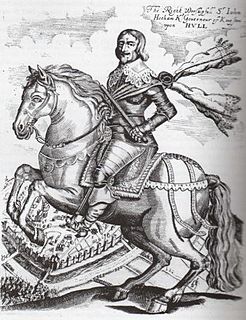Sir George Marwood was a Yorkshire landowner who served as the High Sheriff of Yorkshire in 1651 and was later elected as the Member of Parliament for Northallerton in 1660. [1]
Sir George Marwood was a Yorkshire landowner who served as the High Sheriff of Yorkshire in 1651 and was later elected as the Member of Parliament for Northallerton in 1660. [1]
George Marwood was born in 1601 in Stokesley to Henry and Ann (née Constable) Marwood. [2] His family had been seated at Busby Hall in Little Busby since 1587 [3] and held further property at Wilberfoss, Acomb Grange and Sedbergh. [4] The Marwoods were an ancient family who directly descended from Edward III. [5] He was educated at Lincoln College, Oxford. [6] He married Frances Bethell daughter of Sir Walter Bethell of Alne in 1627. [7]
Marwood had three sons and three daughters: [5]

Duke of Kingston-upon-Hull was a title in the Peerage of Great Britain, with the title Earl of Kingston-upon-Hull being a title in the Peerage of England. The Earldom was created on 25 July 1628 for Robert Pierrepont, 1st Viscount Newark. The Dukedom was created on 10 August 1715 for his great-grandson, Evelyn Pierrepont, 1st Marquess of Dorchester, who had succeeded as the fifth Earl of Kingston-upon-Hull in 1690. The Dukedom became extinct on the death of the second Duke in 1773. Unlike the city to which they refer, Kingston upon Hull, which is usually shortened to Hull, these titles are usually shortened to Duke of Kingston. They should not be confused with the separate Irish Earldom of Kingston.

Robert Pierrepont, 1st Earl of Kingston-upon-Hull was an English nobleman who joined the Royalist side in the English Civil War after some delay and became lieutenant-general of the counties of Lincoln, Rutland, Huntingdon, Cambridge and Norfolk. He was killed in a friendly fire incident after being captured by Parliamentary forces.

Major Henry Somerset, 7th Duke of Beaufort, KG, styled Earl of Glamorgan until 1803 and Marquess of Worcester between 1803 and 1835, was a British peer, soldier, and politician.

Offchurch Bury is a manor house one mile north-west of the centre of the village of Offchurch, Warwickshire, England. It is supposed to represent the site of a palace of the Anglo-Saxon King Offa of Mercia (d.796), after which Offchurch is named, "bury" being a corruption of "burh" meaning a fortified place. William Dugdale in his Antiquities of Warwickshire (1656) stated concerning the manor of Offchurch:

Hengrave Hall is a Grade I listed Tudor manor house in Hengrave near Bury St. Edmunds in Suffolk, England and was the seat of the Kitson and Gage families 1525–1887. Both families were Roman Catholic recusants.

The Sheriff is the oldest secular office under the Crown. Formerly the Sheriff was the principal law enforcement officer in the county but over the centuries most of the responsibilities associated with the post have been transferred elsewhere or are now defunct, so that its functions are now largely ceremonial.
Sir Philip Stapleton of Wighill and of Warter-on-the-Wolds, Yorkshire was an English Member of Parliament, a supporter of the Parliamentary cause during the English Civil War. His surname is also sometimes spelt Stapylton or Stapilton.

John Henry Bethell, 1st Baron Bethell, known as Sir John Bethell, 1st Baronet, from 1911 to 1922, was a British banker and Liberal politician.
Sir Christopher William Codrington, of Dodington, Gloucestershire, was a British MP for East Gloucestershire between 7 August 1834 and 24 June 1864 and a landowner in Gloucestershire.

Robert Spencer, 1st Baron Spencer of WormleightonKG was an English nobleman, peer, politician, landowner, and MP from the Spencer family.
Thomas Clinton, 3rd Earl of Lincoln, was an English peer, styled Lord Clinton from 1585 to 1616.
Sir John Wray, 2nd Baronet was an English politician who sat in the House of Commons at various times between 1614 and 1648. He supported the Parliamentary cause in the English Civil War.

The Marwood Baronetcy, of Little Busby in the County of York, was a title in the Baronetage of England. It was created on 31 December 1660 for George Marwood, Member of Parliament for Malton and Northallerton. The second Baronet also represented Northallerton in Parliament. The title became extinct on the death of the fourth Baronet in 1740.
Thomas Fairfax, 1st Viscount Fairfax of Emley JP was an English landowner and politician who sat in the House of Commons at various times between 1601 and 1626. He was created Viscount Fairfax in the Peerage of Ireland in 1629. He "erected a mansion on Bishophill (York) early in Elizabeth's reign".

The Palmes family of Naburn Hall, and the cadet branches of Lindley Hall, North Yorkshire; Ashwell, Rutland; and Carcraig in Ireland, are an ancient English aristocratic family, noted for their adherence to Catholicism.

Sir Henry Belasyse, 1st Baronet (1555–1624) was an English politician.
Chomley Turner (1685–1757) of Kirkleatham, Yorkshire was a British landowner and politician who sat in the House of Commons between 1715 and 1747.

Sir Henry Marwood (1635-1725) was an aristocratic landowner who served as High Sheriff of Yorkshire in 1674. He was Member of Parliament for Northallerton from 1685 to 1688.

Busby Hall is a Grade II* listed Country House in Little Busby, North Yorkshire, England, close to the village of Carlton-in-Cleveland. The house and parkland sits within the North York Moors National Park.
William Eure, 4th Baron Eure KB was an English nobleman.